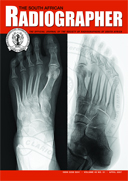Can the anterior-posterior thigh diameter be used as an indicator for fetal age using two-dimensional sonography?
Abstract
Abstract:
This study evaluates the usefulness and direct correlation of a new method of predicting fetal age by the measurement of the anteriorposterior high diameter (APTD) in normal 18 to 28 week pregnancies using two-dimensional sonography. Little published research exists in the area of fetal thigh biometry, specifically in the use of the APTD. The only study the author found was that of fetal thigh circumference. Continuing review of existing practices needs to be coupled with evaluation of alternate or additional methodology.
Material and methods:
This was a quantitative prospective study of 55 patients in a hospital in Alberta, Canada. APTDs were sonographically
measured. The normal range for each week of pregnancy was determined for reliability.
Results: Significant correlation was found between the APTD and fetal age from simple line regression analysis, with 99.9% confidence intervals at each week from 18 to 28 weeks gestation. There was a correlation of 1 mm APTD per one week of fetal age. In addition R >0.93, P< than 0.001. The residual scatter plots confirmed the APTD validity.
Conclusion: APTD is a reliable and valid method for assessing fetal age in a normal pregnancy and may be particularly useful when other parameters are unable to accurately predict fetal age. An accurate linear measurement of multiple fetal parameters allows a more complete profile of fetal growth and estimated date of delivery. APTD may also be useful in identifying fetal growth problems. All of the values of fetal age lie directly on the best-fit regression line. Since the coefficient of determination (Rsq) is very high, this model is very effective.
Downloads
Issue
Section
License
Copyright on all published material belongs to the Society of Radiographers of South Africa (SORSA).I hereby understand and declare that:
- All proprietary rights other than copyright are reserved to the authors, as well as the right to reproduce original figures and tables from this item in their future works, provided full credit is given to the original publication The South African Radiographer ISSN 0258 0241.
- In consideration of the reviewing and editing done by the editors of The South African Radiographer of the above named manuscript, the author/s hereby transfer, assign, or otherwise convey all copyright ownership world-wide, in all languages, to the Society of Radiographers of South Africa in the event that this manuscript is accepted for publication.
- If the manuscript has been commissioned by another person or organisation, or if it has been written as part of the duties of an employee, that full authorization has been given by the representative of the commissioning organisation or employer to be published in the The South African Radiographer.


